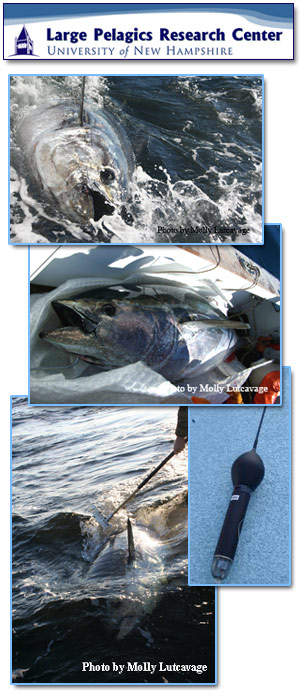 | In this Section: | |  | In the Spotlight |  | News |  |
List of "In the Spotlight" Features
Introducing Exciting New Data for Bluefin Tuna

|
U.S. Satellite Laboratory is pleased to welcome new partner, The Large Pelagics Research Center at the University of New Hampshire. Director, Dr. Lutcavage and her team of marine scientists, track and study Atlantic bluefin tuna in an effort to learn about their life history, migration patterns, reproductive behavior and population dynamics. Signals of Spring students now have a wonderful opportunity to track this fish species and investigate new data sets including depth, transmitted with "pop-up" archival satellite (PSAT) tags.
Bluefin are a fascinating species with unique adaptations for life in the ocean. They are extremely fast swimmers and migrate great distances. They must keep moving at all times in the water, which requires a great deal of energy. Bluefin feed on high energy fish such as herring and mackerel when near the coast as well as squid when in the open ocean. They are tremendous divers with a large depth range, comparable to sperm whales, of up to 12,000 feet. When they dive, they are exposed to a wide range of temperatures. Bluefin are able to function in variable temperatures because they are warm bodied and can keep their internal temperature stable. While marine mammals also have this ability, it is a pretty amazing adaptation for a fish!
"Bluefin are a highly migratory species with a complex life history which makes them hard to study," explains Dr. Luctavage. For years, scientists believed that there are two populations of Atlantic bluefin that spawn in different areas (the Mediterranean Sea and the Gulf of Mexico) and have very low mixing rates. However, recent research suggests that this may not be true. One of Dr. Luctavage's main objectives is to gain a clearer picture of where and when and how often bluefin spawn to ultimately understand their reproductive biology. "Bluefin tuna have very specific temperature and productivity requirements for larval development," she explains. "We can't tell if a fish is spawning based on data returned from current satellite tags, but we can identify where they are during a presumed spawning season and whether the conditions are right for spawning and larval development."
Some of the most interesting information that Dr. Lutcavage's team is collecting via PSAT tags is depth data. Depth (via a pressure sensor) and ambient temperature are recorded by tag sensors every 15 minutes, along with ambient light level (used to estimate a daily location), to provide a complete picture of the bluefin's habitat preferences. The PSAT tags used to study bluefin tuna are a little different than some used to study marine mammals. PSAT tags store data and transmit it as a radio signal only when the tag detaches from the fish and surfaces. As a result, data for up to twelve months is transmitted all at once. This type of tag is called a "pop-up" tag because the data logger and float are programmed to detach from the animal and float to the surface. The radio transmitter in the tag then broadcasts the data to a receiver on orbiting NOAA satellites, and the data is processed and distributed to the user. Tags are intended to stay on bluefin tuna for about 1 year, however, only about 1/3 of the tags so far have remained on that long because of the difficult process of keeping the tag on a highly mobile fish.
When Dr. Luctavage began tagging bluefin tuna about ten years ago, she depended on the knowledge and skill of fisherman to develop tagging methods. "The fishermen were vital in our research efforts," she comments. "We depended on their knowledge and skill to help catch the fish and develop techniques for safely attaching the PSAT tag to an 800 pound tuna." The fishermen Dr. Luctavage and collaborators work with were, and still are, interested in conserving the Atlantic bluefin population and subsequently, their livelihood. "Sadly, some of the New England fishermen we started this cooperative tagging research with are now out of business because of overfishing in the Eastern Atlantic and Mediterranean Sea, where other countries are not complying with scientific advice, and aren't adhering to acceptable levels of sustainable fishing," Dr. Luctavage explains.
While many conservation issues are the same for large pelagic fishes and marine mammals, one of the most important differences is that fish are specifically targeted by international fisheries. Marine mammals, on the other hand, are not usually targeted, but are accidentally caught in fishing gear. While Atlantic bluefin tuna are not yet listed as an endangered species, overfishing is a serious concern. Dr. Luctavage's research will ultimately lead to a more complete scientific understanding of Atlantic bluefin so that fisheries managers can find the best ways to manage and rebuild fisheries and conserve the population.
There are many interesting questions for Signals of Spring students to ask upon observing the bluefin tracks and data sets. Check out the new link on the maps and data page as well as research links for Atlantic bluefin tuna. You'll find them a fascinating species!
Click here to see tracks from 2002.
Click here to see tracks from 2003.
|
